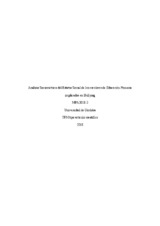Análisis Sociométrico del Estatus Social de los escolares de Educación Primaria implicados en Bullying
Estatus Social de los implicados en Bullying
Autor
Bravo Castillo, Ana
Tutor
Romera Félix, Eva M.Ortega Ruiz, Rosario
Editor
Universidad de CórdobaFecha
2020Materia
Redes socialesBullying
Aceptación
Rechazo
Amistad
Popularidad
Social networks
Roller bullying
Like
Dislike
Friendship
METS:
Mostrar el registro METSPREMIS:
Mostrar el registro PREMISMetadatos
Mostrar el registro completo del ítemResumen
Este estudio se enmarca dentro del conjunto de investigaciones sobre acoso escolar, dirigidas a describir las características diferenciales en las dimensiones del estatus social -popularidad, aceptación social y amistad- en los roles del bullying. El objetivo del estudio fue dar respuesta a la necesidad de explorar las características individuales, de la red-clase y de la red de chicos y de chicas, en relación al estatus social de los roles del bullying. Los participantes fueron 397 escolares (49% chicas) de 19 aulas de quinto y sexto de Educación Primaria, quienes nominaron a sus compañeros y compañeras de clase en base a su estatus social y rol en el bullying -agresor, defensor y víctima-. Los análisis de redes mostraron a nivel de la red-clase, altos niveles de centralización y densidad en las dimensiones de amistad y aceptación; a nivel relacional, una alta prevalencia de relaciones diádicas de rechazo entre las víctimas y los defensores y de popularidad de las defensoras hacia los agresores. El análisis del efecto de la interacción del sexo de los participantes señaló diferencias en las características del perfil social de las víctimas y los agresores en función del sexo. Los resultados fueron discutidos en base a la importancia de estudiar el acoso escolar desde una perspectiva relacional y dinámica. Se subrayan las aportaciones que suponen para futuras investigaciones y programas de intervención. This study is framed within the set of research on bullying, aimed at describing the differential characteristics in the dimensions of social status -popularity, social acceptance and friendship- in roles of bullying. The objective of study was to respond to the need to explore individual, network-class and network boys and girls’ characteristics, in relation to social status of roles of bullying. Participants were 397 schoolchildren (49% girls) from 19 fifth and sixth classrooms of Primary Education, whom nominated to their peer about the social status and role of bullying -bully, defender and victim-. Network analysis shows at class-network, high level of centralization and density in the dimensions of friendship and acceptance; at relational level, a high prevalence of dyadic rejection relationships between victims and defenders, and dyadic popularity relationships of defender girls towards bully boys. The analysis of effect of interaction of sex of participants indicated differences in the characteristics of social profile of victims and aggressors according to sex. Results were discussed based on the importance of studying bullying from a relational and dynamic perspective. It bases the contributions that suppose for the future investigations and programs of intervention.
Descripción
Premio extraordinario de Trabajo Fin de Máster curso 2017/2018. Máster en Psicología Aplicada a la Educación y el Bienestar Social

